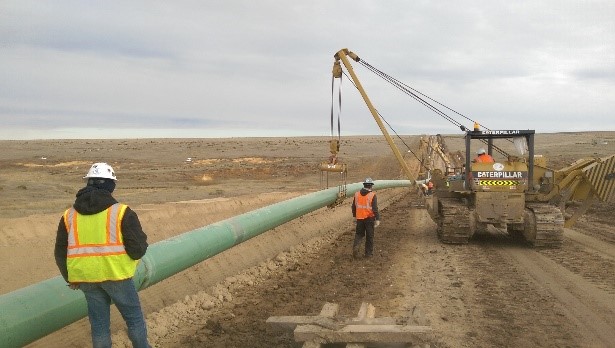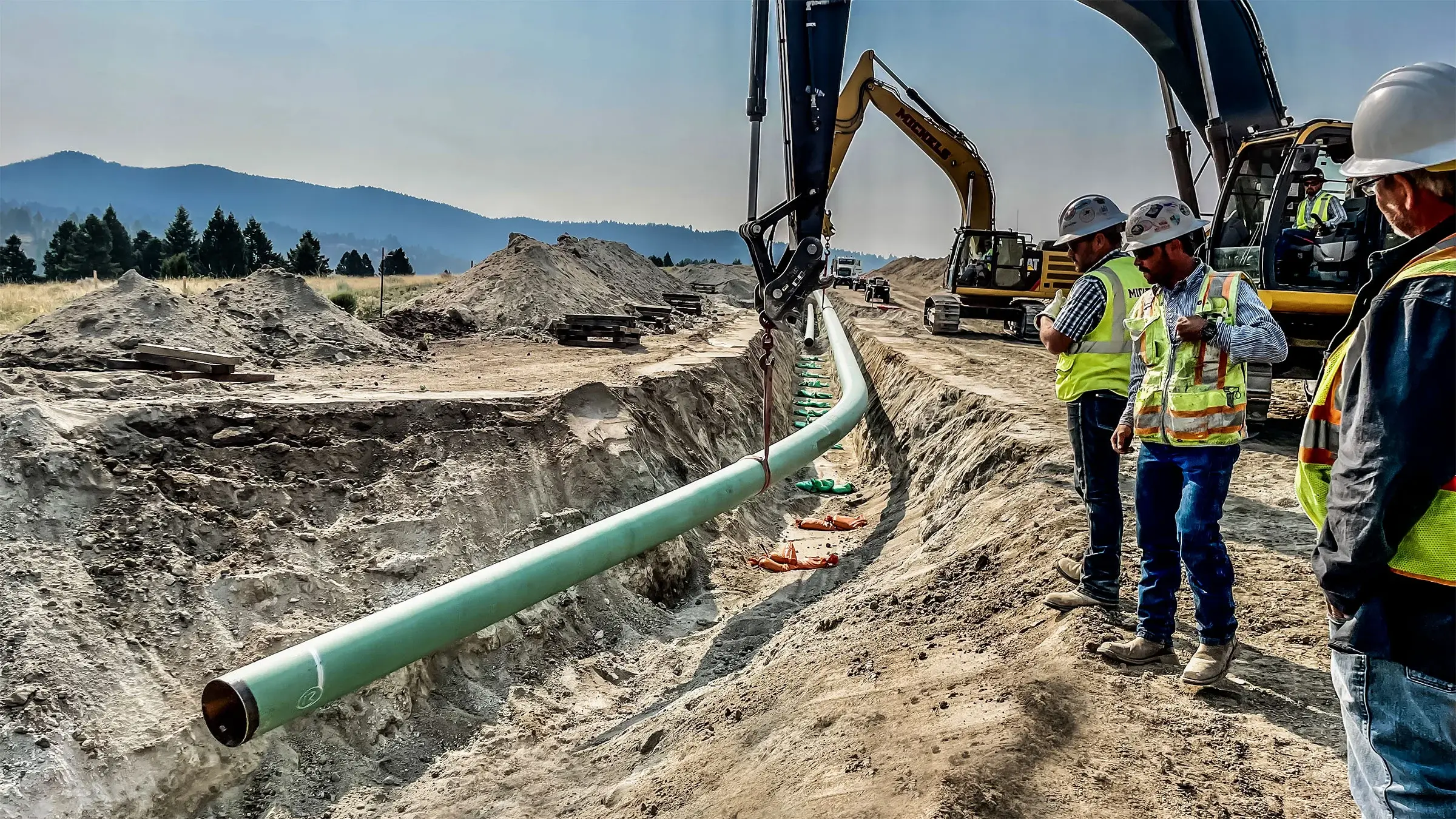How Pipeline Construction Authority Supports Efficient Energy Transport
Discovering the Future of Pipeline Construction: Fads and Technologies to Watch
The pipiline construction industry is on the brink of considerable advancement, driven by advancements in materials, automation, and sustainability techniques. With the introduction of innovative composite materials and the combination of robotic innovations, tasks are becoming not only extra effective but likewise more secure and eco accountable. Additionally, wise monitoring systems are readied to revolutionize upkeep protocols through real-time data analytics. As these fads unravel, the ramifications for regulative compliance and market standards become significantly important. What remains to be seen is how these developments will certainly reshape the landscape of pipiline construction in the coming years.
Arising Materials in Pipeline Construction
Recent developments in pipiline construction have actually highlighted the importance of innovative products that boost longevity and effectiveness. The industry has progressively transformed to composite products, such as fiberglass enhanced plastic (FRP) and carbon fiber, as a result of their premium strength-to-weight proportions and resistance to deterioration. These products significantly prolong the life-span of pipelines, reducing the demand for constant upkeep and replacement, which can be both pricey and disruptive.Another exceptional growth is the usage of high-density polyethylene (HDPE), which has actually gotten grip for its adaptability and resistance to splitting and environmental anxiety. HDPE pipelines are particularly advantageous in applications where ground movement poses a risk, as they can stand up to considerable deformation without falling short. Additionally, the lightweight nature of HDPE facilitates much easier transportation and installment, further improving job efficiency. Pipeline Construction Authority.Moreover, innovations in nanotechnology have paved the method for the development of materials with boosted residential or commercial properties. Integrating nanoparticles into typical polymers or metals can improve strength, reduce weight, and even pass on self-healing capacities, considerably enhancing the longevity of pipiline systems.Lastly, the combination of clever materials, which can respond to ecological modifications, represents a frontier in pipiline construction. These products can keep track of tension and deterioration in real-time, enabling proactive maintenance and lowering the likelihood of disastrous failures
Automation and Robotics in Construction
In an era where performance and precision are vital, the integration of automation and robotics in pipiline construction is transforming sector methods. This technical development is poised to improve performance while minimizing human mistake, consequently dealing with a few of the longstanding challenges in this sector.Robotic systems are increasingly utilized for jobs such as welding, assessment, and excavation. Midland Pipeline Construction Authority. These devices can operate in harmful atmospheres where human visibility might be dangerous, therefore safeguarding employee health and wellness. On top of that, automated welding robots assure constant high quality and decrease the possibility of flaws, which can have significant financial implications.Drones are one more vital component of this improvement. They are utilized for aerial surveying and mapping, giving real-time information that can educate task preparation and execution. This capability enables project supervisors to make educated decisions quickly, enhancing source allocation and reducing delays.Furthermore, the use of automation in pipiline construction permits increased accuracy in jobs such as pipe alignment and installation. This degree of precision not only boosts the honesty of the pipiline system yet additionally reduces the need for costly rework.As the market remains to embrace these innovations, the capacity for enhanced efficiency and lowered operational costs becomes apparent. The relocation in the direction of automation and robotics is not just a trend however a strategic reaction to the evolving needs of pipiline construction, establishing a brand-new requirement for future jobs. The recurring advancement in this area will certainly shape the landscape of construction, driving advancement and competitive advantage
Smart Checking Technologies
The landscape of pipiline construction is increasingly being shaped by smart tracking technologies that enhance operational oversight and maintenance performance. These innovative systems utilize a mix of sensing units, information analytics, and real-time communication to give detailed understandings into pipiline problems, making it possible for drivers to make informed decisions quickly.One of the essential elements of wise monitoring modern technologies is the deployment of Internet of Points (IoT) sensors along pipiline networks. These sensors constantly gather data on various parameters, including stress, temperature, and circulation prices. By leveraging this information, drivers can determine anomalies that might show possible leaks or other concerns, permitting prompt treatments that avoid costly failings and environmental damage.Moreover, the integration of artificial intelligence algorithms right into keeping track of systems enables anticipating maintenance approaches. By analyzing historical information and acknowledging patterns, these formulas can anticipate possible equipment failures prior to they take place, greatly lowering downtime and repair expenses. In addition, cloud-based platforms promote the centralized storage and analysis of information, making it easily accessible to stakeholders despite location.Furthermore, clever monitoring innovations can boost safety procedures by offering real-time alerts to drivers relating to hazardous conditions. This aggressive method not only safeguards personnel however also ensures compliance with governing criteria.
Lasting Practices and Products
As the pipiline construction market progresses, the unification of eco-friendly materials has actually become a critical focus for minimizing environmental effect. Innovations in lasting materials not just boost architectural stability yet additionally contribute to lowering the general carbon footprint of pipiline jobs. By focusing on these practices, companies can align with worldwide sustainability goals while maintaining operational efficiency.
Eco-Friendly Materials Innovations
Innovations in environment-friendly materials are changing pipiline construction, cultivating lasting practices that lessen environmental impact. As the market faces raising pressure to lower its eco-friendly impact, materials such as bio-based plastics, recycled metals, and composite materials are getting grip. These choices not only give toughness and strength but additionally substantially decrease reliance on fossil fuels.Bio-based plastics, originated from eco-friendly sources, use a sustainable choice for pipiline layers and cellular linings, enhancing resistance to rust and chemical damages. Recycled metals, sourced from deactivated pipelines and various other facilities, add to a circular economic situation by reducing waste and saving natural resources. Furthermore, progressed composite products, which combine fibers and resins, present a lightweight yet durable solution, decreasing transport emissions and helping with easier installation.Additionally, innovations in coatings that use non-toxic, eco-friendly materials are additionally improving the sustainability of pipiline construction. These innovations not just protect pipelines from ecological dangers but additionally minimize contamination dangers throughout operations. By accepting these environment-friendly materials, the pipiline construction industry is taking substantial strides toward a more sustainable future while resolving journalism difficulties posed by climate change and resource exhaustion.
Reducing Carbon Footprint
Stressing sustainable methods and products Texas Pipeline Construction Excellence is vital for pipiline construction to properly decrease its carbon footprint. The industry is significantly adopting innovative strategies that prioritize ecological stewardship while maintaining functional efficiency. One considerable pattern is using low-carbon materials, such as recycled steel and bio-based polymers, which not just minimize greenhouse gas exhausts throughout manufacturing however likewise boost the sturdiness of pipelines.Additionally, advanced construction techniques, including modular construction and prefabrication, streamline the building procedure, thereby minimizing waste and power usage. Implementing electronic innovations like building info modeling (BIM) enables even more accurate task planning and source appropriation, more mitigating ecological impacts.Moreover, pipiline operators are checking out renewable resource sources for operational power, reducing reliance on fossil gas. The assimilation of carbon capture and storage space (CCS) innovations is also obtaining grip, providing an approach to offset discharges connected with pipiline operations.Ultimately, the commitment to lasting methods in pipiline construction not only addresses governing demands yet also replies to expanding public demand for ecologically responsible facilities. By taking on these methods, the industry can lead the way towards an extra lasting future while making sure the stability and effectiveness of pipiline systems.
Digital and Simulation
While the construction sector has actually commonly counted on physical models and hands-on procedures, the appearance of electronic doubles and simulation innovations has actually changed task planning and implementation. Digital doubles are online reproductions of physical possessions that integrate real-time information, allowing stakeholders to visualize and take care of pipiline jobs a lot more properly. By producing a thorough electronic model, project teams can evaluate performance, forecast results, and make notified choices throughout the construction lifecycle.Simulation modern technologies further enhance this procedure by allowing groups to examine numerous situations and assess their potential influences prior to application. This ability is especially vital in pipiline construction, where environmental problems, regulative demands, and logistical challenges can considerably affect project timelines and costs. By click for source replicating different circumstances, designers can recognize excellent construction methods, source allotments, and timetables, eventually lessening dangers and enhancing efficiency.Additionally, digital doubles help with boosted collaboration among project stakeholders. As information is continually updated in real-time, all included celebrations have accessibility to the exact same data, fostering transparency and making sure alignment on project goals. This seamless combination of info can bring about quicker decision-making and more active reactions to unanticipated obstacles.
Improved Security Actions

Regulative Changes and Compliance
Regulative adjustments and conformity are important elements shaping the landscape of pipiline construction. As ecological concerns and public security proceed to acquire prominence, governing bodies are increasingly applying strict guidelines that govern every facet of pipiline jobs (Pipeline Construction Excellence). These policies include a variety of elements, including exhausts criteria, land use, and river defense, requiring that business stay watchful and adaptable.In recent years, we have actually witnessed a significant change towards extra durable compliance structures. Agencies such as the Pipeline and Hazardous Materials Safety And Security Management (PHMSA) in the United States have actually introduced comprehensive guidelines targeted at lessening threats connected with pipiline procedures. This includes mandates for sophisticated surveillance innovations and normal examinations to guarantee adherence to safety standards. As a result, organizations need to spend in training and resources to meet these evolving requirements.The global landscape is not fixed; global arrangements and regional regulations also contribute in shaping conformity practices. Companies took part in cross-border jobs must navigate a complicated internet of legal responsibilities that differ from area to area, commonly causing enhanced functional expenses and job delays.Furthermore, the trend towards increased transparency and public involvement is improving just how business come close to pipiline construction. Stakeholder input is currently extra crucial than ever before, calling for firms to be aggressive in resolving area issues related to ecological influence and safety
Regularly Asked Questions
What Are the Key Challenges Dealing With Pipeline Construction Today?

Exactly How Does Environment Change Influence Pipeline Construction Practices?
Environment modification greatly affects pipiline construction methods by requiring boosted environmental evaluations, boosted governing conformity, and the fostering of resistant facilities styles (Professional Oilfield Services Texas). These adaptations aim to alleviate risks linked with go to website severe climate events and changing environmental conditions

What Functions Do Stakeholders Play in Pipeline Project Growth?
Stakeholders in pipiline job growth include governmental companies, ecological organizations, neighborhood neighborhoods, and investors. Their functions encompass regulatory conformity, environmental assessments, area interaction, and financial assistance, ensuring jobs straighten with social demands and sustainability goals.
Exactly How Is Public Understanding Influencing Pipeline Construction Projects?

Public understanding significantly influences pipiline construction jobs, as community issues concerning ecological impact, security, and economic advantages can cause raised analysis, regulative difficulties, and job delays, ultimately shaping the decision-making procedures of stakeholders involved.
What Is the Future Task Market Expectation for Pipeline Construction Professionals?
The future work market for pipiline construction specialists shows up appealing, driven by boosting infrastructure financial investments and technical advancements. Need for proficient labor is expected to rise, highlighting the demand for training in arising construction methods and safety methods.